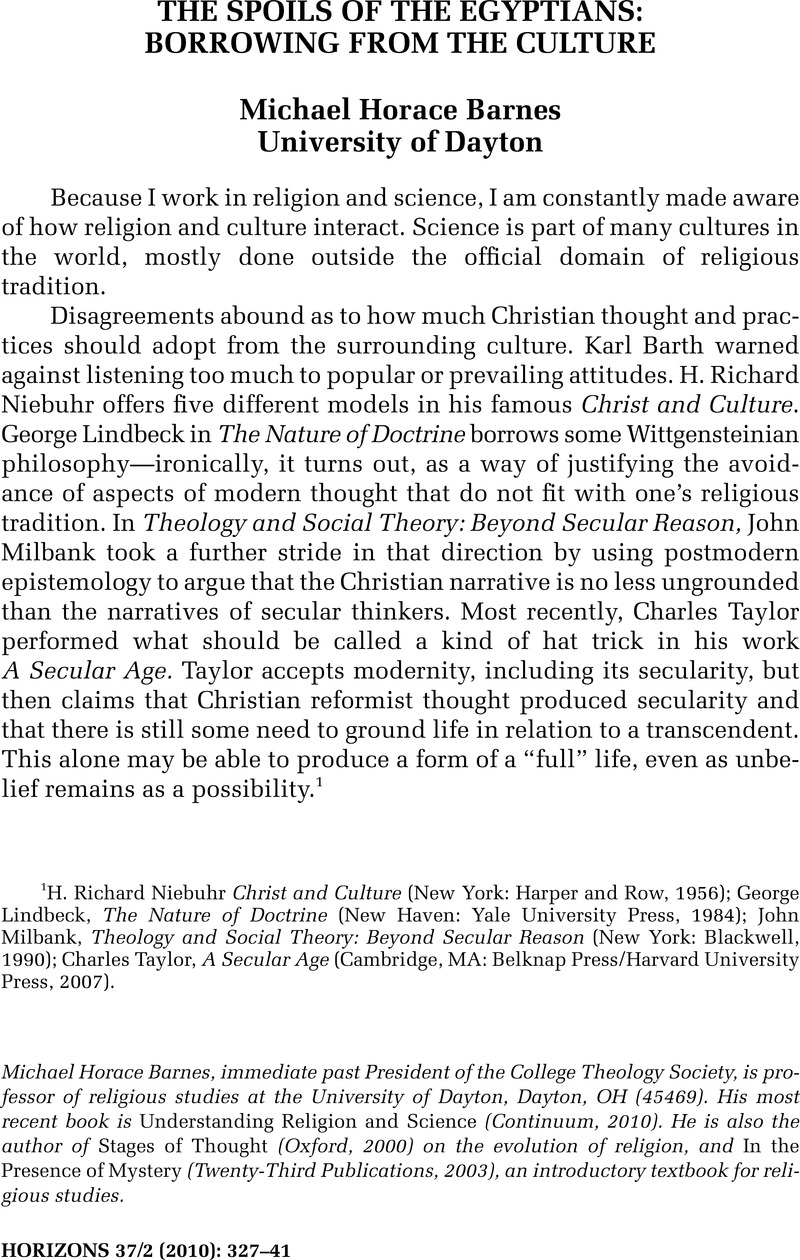No CrossRef data available.
Article contents
The Spoils of the Egyptians: Borrowing from the Culture
Published online by Cambridge University Press: 18 March 2013
Abstract

- Type
- College Theology Society Presidential Address
- Information
- Copyright
- Copyright © The College Theology Society 2010
References
1 Niebuhr, H. RichardChrist and Culture (New York: Harper and Row, 1956)Google Scholar; Lindbeck, George, The Nature of Doctrine (New Haven: Yale University Press, 1984)Google Scholar; Milbank, John, Theology and Social Theory: Beyond Secular Reason (New York: Blackwell, 1990)Google Scholar; Taylor, Charles, A Secular Age (Cambridge, MA: Belknap Press/Harvard University Press, 2007).Google Scholar
2 Many who comment on Taylor's work describe any culture as porous to outside sources, in different ways. See Warner, Michael, Antwerpen, Jonathan Van, and Calhoun, Craig, eds., Varieties of Secularism in a Secular Age (Cambridge, MA: Harvard University Press, 2010)Google Scholar; this includes an extensive “Afterword” by Taylor, who summarizes his ideas in response to the analyses and criticisms offered in the other chapters.
3 Letter of Origen to Gregory, in Ante-Nicene Fathers: The Writings of the Fathers down to A.D. 325, ed. Roberts, Alexander and Donaldson, James; rev. A. Cleveland Coxe, vol. 9Google Scholar, Original Supplement to the American Edition, 5th ed., ed. Menzies, Allan (1896; reprint, Grand Rapids, MI: Eerdmans, 1955), 295–97, cited from http://www.fordham.edu/halsall/source/origen1.htmlGoogle Scholar (accessed 17 October 2010).
4 The Prescription Against Heretics, 7, trans. Holmes, Peter, http://www.tertullian.org/anf/anf03/anf03-24.htm (accessed 14 October 2010).Google Scholar
5 Augustine, , On the Literal Meaning of Genesis, 2 vols., trans. Taylor, John Hammond, Ancient Christian Writers, vols. 41–42 (New York: Newman Press, 1982), 1.19.3 (41:42–43).Google Scholar
6 Ibid., 43.
7 Finocchiaro, Maurice A., ed. and trans., The Galileo Affair: A Documentary History (Berkeley, CA: University of California Press, 1989), 290.Google Scholar
8 Kwilecki, Susan, “A Scientific Approach to Religious Development: Proposals and a Case Illustration,” The Journal for the Scientific Study of Religion 27/3 (1988): 307–25.CrossRefGoogle Scholar
9 As an example of one who has attempted to do this, see Barnes, Michael Horace, Stages of Thought: The Co-Evolution of Religious Thought and Science (New York: Oxford University Press, 2000).Google Scholar
10 Ibid., chap. 2 reviews much of the recent literature and arguments on this topic.
11 For example, Rest, James, Narvaez, Darcia, Bebeau, Muriel, and Thoma, Stephen, Postconventional Moral Thinking: A Neo-Kohlbergian Approach. (Mahwah, NJ: Lawrence Erlbaum Associates, 1999).Google Scholar For other recent studies, see e.g. Killen, Melanie and Smetana, Judith G., eds., Handbook of Moral Development (Mahwah, NJ; Lawrence Erlbaum Associates, 2006.)Google Scholar
12 For example, Rest, James et al. , Postconventional Moral Thinking: A Neo-Kohlbergian Approach (Mahwah, NJ: L. Erlbaum Associates, 1999).Google Scholar For other recent studies, see e.g. Killen, Melanie and Smetana, Judith G., eds., Handbook of Moral Development (Mahwah, NJ: L. Erlbaum Associates, 2006.)Google Scholar
13 MacIntyre, Alisdair C., After Virtue: A Study in Moral Theory (Notre Dame, IN: University of Notre Dame Press, 1981), ch. 14Google Scholar, “The Nature of the Virtues.” See also Hauerwas, Stanley, A Community of Character: Toward a Constructive Christian Social Ethic (Notre Dame, IN: University of Notre Dame Press, 1981)Google Scholar or idem, Christians Among the Virtues: Theological Conversations With Ancient and Modern Ethics (Notre Dame, IN: University of Notre Dame Press, 1997). For a greater range of views, see Lapsley, Daniel K. and Power, F. Clark, eds., Character Psychology and Character Education. (Notre Dame, IN: University of Notre Dame Press, 2005).Google Scholar
14 For details, see Peterson, Robin, “Excommunicated Over Abortion,” http://inthese-times.com/article/6541/excommunicated_over_abortion (accessed 16 October 2010).Google Scholar
15 Boas, in fact, does propose a number of aspects of culture which represent evolutionary stages. See Boas, Franz, The Mind of Primitive Man, rev. ed. (New York: Macmillan, 1992Google Scholar [orig. 1911, 1938]. For a summary see Stages of Thought, 34–35.)
16 As in Eliade, Mircea, The Sacred and the Profane: The Nature of Religion, trans. Trask, Willard R. (New York: Harper Torchbook, 1961), 2.Google Scholar
17 Robert Bellah, “Religious Evolution,” in idem, Beyond Belief (San Francisco: Harper and Row, 1970), originally published in American Sociological Review 29 (1964): 358–74.
18 Parsons, Talcott, The Evolution of Societies, ed. Toby, Jackson (Englewood Cliffs, NJ: Prentice-Hall, 1977).Google Scholar
19 The HRAF include studies of over 300 distinct cultures, many of which have been the object of studies by many different people. The Files contain both ethnographic and archeological materials, for the sake of making comparisons across cultures and through time.
20 See Stages of Thought, chap. 5 for a further analysis of the nature of axial age thought.
21 Among more recent works I recommend Collins, Randall, The Sociology of Philosophies: A Global Theory of Intellectual Change (Cambridge, MA: Harvard University Press, 1998)Google Scholar; Hallpike, C. R., The Principles of Social Evolution (New York: Oxford University Press, 1988)Google Scholar; idem, The Evolution of Moral Understanding (London: Prometheus Research Group, 2004). For an example of a careful study of a specific culture at a specific time, see Roetz, Heiner, Confucian Ethics of the Axial Age: A Reconstruction Under the Aspect of the Breakthrough Toward Postconventional Thinking (Albany, NY: State University of New York Press, 1993)Google Scholar, or any work by Geoffrey Lloyd.
22 See Smith, Mark S., The Early History of God: Yahweh and Other Deities in Ancient Israel, 2nd ed. (Grand Rapids, MI: Eerdmans, 2002)Google Scholar and Gnuse, Robert, No Other Gods: Emergent Monotheism in Israel. (Sheffield: Sheffield Academic Press, 1997)Google Scholar for reviews of archeological evidence.
23 For a summary version see http://faculty.virginia.edu/haidtlab/mft/index.php (accessed 17 October 2010). Note the link at the left to “publications.” Of these I recommend, Graham, J., Haidt, J., and Nosek, B. A., “Liberals and conservatives rely on different sets of moral foundations,” Journal of Personality and Social Psychology (2009)CrossRefGoogle ScholarPubMed, as an example of empirical research on such topics.




